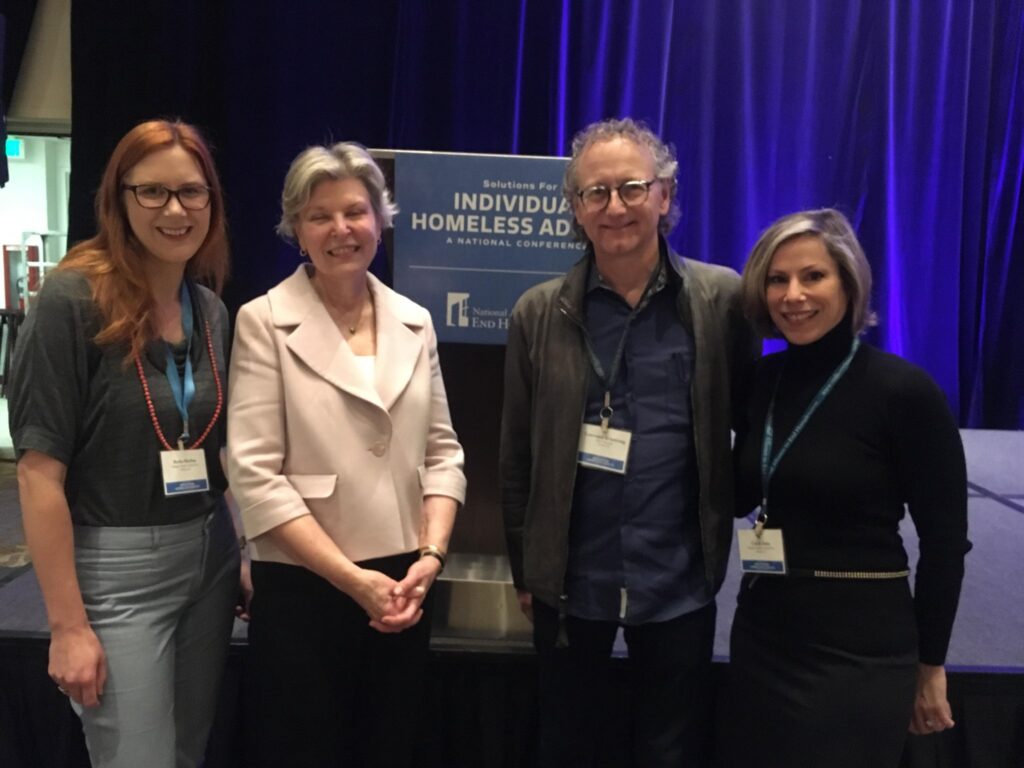What We Learned at the National Alliance to End Homelessness Conference

In February 2019, a team from United To End Homelessness attended the Solutions for Individual Homeless Adults Conference in San Diego. Organized by the National Alliance to End Homeless (NAEH).
Organized by the National Alliance to End Homelessness (NAEH), the aim of the conference was to provide those engaged in the nationwide effort to combat homelessness with important new tools, best practices, and successful strategies, especially as it relates to individual homeless adults, the largest percentage of the U.S. homeless population. Speakers included officials from the U.S. Department of Housing and Urban Development (HUD), national business leaders and some of the nation’s best academic minds.
The conference also focused on the importance of the “Housing First” approach, in which the focus of programs is housing people first, and then helping them with lifestyle or other issues that may be challenging them once they are in stable housing. Our team at the conference was particularly interested in housing innovations that were successfully implemented in Chicago, Oregon, and elsewhere in California.
Collaboration is Key When it Comes to Funding
In Chicago, collaboration with insurance companies and healthcare agencies was key to securing funding for housing projects in that city.
Companies in these industries found that investing in the construction of new housing projects serves their interests along with that of the community as it drastically reduces the number of insurance claims, and thus the overall cost of healthcare. The University of Illinois Hospital, for example, is investing in housing for chronically homeless individuals as those outlays pale in comparison to costs associated with emergency medical care for unsheltered homeless individuals.
Hospitals and insurance companies throughout the state of Oregon are also collaborating to provide housing for homeless individuals. Healthcare organizations such as Adventist Health Portland, CareOregon, Kaiser Permanente Northwest and others are investing $21.5 million to build 382 new housing units in Portland. While drastically reducing healthcare costs for these organizations and taxpayers (ER costs upwards of $3,000 per visit), this investment also creates healthier and more economically stable communities.
In California, the State has allocated $2 billion in bond money to help build Permanent Supportive Housing (PSH) for the homeless, particularly in Los Angeles County, where there are an estimated 52,765 homeless without shelter. Although this money is currently tied up in litigation, counties throughout the state have already enacted plans to apply the funds to building housing, particularly for homeless individuals suffering from mental illness.
In June 2018, former Governor Jerry Brown signed into law the Homeless Emergency Aid Program (HEAP), which allowed for a block grant of $500 million to be allocated to cities and counties based on their 2017 homeless Point in Time Counts. Orange County is among over 40 counties and cities qualified to apply for these funds,
Boosting Outreach Efforts
The conference also brought to light many successful approaches to finding and engaging individual homeless adults, including strategies employed in the Bronx, New York.
Bronxworks, a human services organization dedicated to improving the economic and social well-being of individuals and families, has devoted substantial resources to increasing their outreach staff. They found that having a dedicated outreach provider in each city borough helped not just to locate new individual homeless adults but also establishing relationships and mutual trust. This allowed for easier and more accurate data collection, which in turn helped Bronxworks establish partnerships with hospitals, health care providers, shelters, and other local nonprofits.
Similarly, the Los Angeles County Homeless Initiative has been able to triple its number of outreach staff due to the Measure H sales tax, which provides $355 million annually to LA County. These funds have allowed for the tripling of outreach services throughout the county as well as providing additional emergency shelters, rapid rehousing and supportive housing services.
In Southern Nevada, organizations like HELP are fighting to serve the poor, homeless and those in crisis with innovative ways to engage the individual homeless adult population. They have a Mobile Crisis Intervention Team which helps locate homeless individuals and provide them with wrap-around services until they are housed. They also work with the Las Vegas Metropolitan Police Department to increase their outreach services and locate homeless individuals in crisis.
KEY TAKEAWAYS: COLLABORATION AND OUTREACH KEYS TO ENDING HOMELESSNESS
Our team appreciated the opportunity to learn from and interact with others engaged in their respective fights to end homelessness, and analyze several successful strategies that can be applied here in Orange County, including:
- Collaboration: Cities, counties, and nonprofits are most successful at reducing the homeless population when they are able to collaborate with hospitals, healthcare providers and insurance companies in funding housing projects.
- Outreach: Increasing staffing and programs for homeless outreach are key strategic components in ending homelessness.
This conference served as one more step on the road to ending our homeless crisis here in Orange County. To learn more about our campaign and ways you can help us achieve our mission, click here.